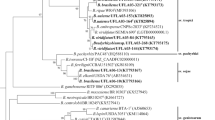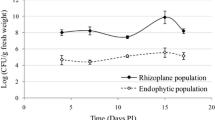Summary
The effects of temperature on growth in broth and soil and on competition for nodule formation betweenRhizobium japonicum serotypes USDA 76 and 94 compared to 6 and 110 were studied. Increasing root temperatures of Lee soybean from 20 to 35°C increased the competitiveness of 76 and 94 relative to 6 and 110 for all inoculum ratios such that at 30 and 35°C symptoms ofRhizobium-induced chlorosis appeared. Tolerance to elevated temperatures was exhibited by 76 and 110, but not 94 and 6 in broth and soil which suggested that increased competitiveness of 76 and 94 at high soil temperatures was not dependent upon growth at elevated temperatures. Nodulation and vegetative growth of Lee soybeans were at a minimum at 20°C and optimum at 30°C. Differences in competitiveness of 6 to previous studies indicated the need to standardize temperatures of assays. Differences in growth responses of 76 and 94 to temperature from a previous study suggested a confounding effect on different carbon sources in growth media.
Similar content being viewed by others
References
Boonkerd N and Weaver R W 1982 Survival of cowpea rhizobia in soil as affected by soil temperature and moisture. Appl. Environ. Microbiol. 43, 585–589.
Caldwell B E 1969 Initial competition of root-nodule bacteria on soybeans in a field environment. Agron. J. 61, 813–815.
Caldwell B E and Weber D F 1970 Distribution ofRhizobium japonicum serotypes in soybean nodules as affected by planting dates. Agron. J. 62, 12–14.
Danso S K A and Alexander M 1974 Survival of two strains ofRhizobium in soil. Soil Sci. Soc. Am. Proc. 38, 86–89.
Erdman L W, Johnson H W and Clark F 1957 Varietal responses of soybeans to a bacterial-induced chlorosis. Agron. J. 49, 267–271.
Gibson A H 1977 The influence of the environment and managerial practices on the legume-rhizobium symbiosis.In A Treatise on Dinitrogen Fixation. Section IV Agronomy and ecology. Eds R W F Hardy and A H Gibson Wiley-Interscience. New York pp 393–450.
Hardarson G and Jones D G 1979 Effect of temperature on competition amongst strains ofRhizobium trifolli for nodulation of two white clover varieties. Annals of Appl. Biol. 92, 229–236.
Johnson H W and Means U M 1964 Selection of competitive strains of soybean nodulating bacteria. Agron. J. 56, 60–62.
Jones D G and Morley S J 1981 The effect of pH on host plant preference for strains ofRhizobium trifolii using fluorescent ELISA for strain identification. Annals of Appl. Biol. 97, 183–190.
Kuykendall L D and Elkan G H 1976Rhizobium japonicum derivatives differing in nitrogen fixing efficiency and carbohydrate utilization. Appl. Environ. Microbiol. 32, 511–519.
Means U M, Johnson H W and Erdman L W 1961 Competition between bacterial strains effecting nodulation in soybeans. Soil Sci. Soc. Am. Proc. 25, 105–108.
Means U M, Johnson H W and Date R A 1964 Quick serological method of classifying strains ofRhizobium japonicum in nodules. J Bacteriol. 87, 547–553.
Munevar F 1981 Studies of the Soybean-Rhizobium Association as Affected by High Root Temperature. Ph.D. thesis, North Carolina State University.
Roberson R S 1978 Laboratory Exercises in Immunology. Department of Microbiol. Publication, University of Maryland.
Vincent J M 1970 A Manual for the Practical Study of the Root Nodule Bacteria. IBP Handbook 15. Blackwell Publishers, Oxford.
Weber D F and Miller V L 1972 Effect of soil temperature onRhizobium japonicum serogroup distribution in soybean nodules. Agron. J. 64, 796–798.
Author information
Authors and Affiliations
Additional information
Scientific Article No. A-3721 Contribution No. 6697 of the Maryland Agric Exp Sta, Dept of Agronomy, College Park, MD 20742 and the USDA, ARS, Beltsville, MD 20705. Part of a thesis submitted by the senior author in partial fulfillment of the requirements for the M.S. Degree.
Rights and permissions
About this article
Cite this article
Kluson, R.A., Kenworthy, W.J. & Weber, D.F. Soil temperature effects on competitiveness and growth ofRhizobium japonicum and on Rhizobium-induced chlorosis of soybeans. Plant Soil 95, 201–207 (1986). https://doi.org/10.1007/BF02375072
Received:
Revised:
Issue Date:
DOI: https://doi.org/10.1007/BF02375072




